
Rafael Pérez Evans. Photo courtesy of Jerry Hardman-Jones, The Henry Moore Institute 2021.
by ANNA McNAY
Rafael Pérez Evans (b1983, Málaga) is best known for Grounding (2020), his installation at Goldsmiths, University of London, for which he dumped 29 tonnes of carrots in the college courtyard. This was a recognition of farmers’ protests, across Europe, at the devaluation of their produce and labour; the separation of the city from the processes of food production; and the forced “modernisation” of rural farming communities in southern Europe – such as the one near Málaga, where he grew up – that have been rendered unsustainable and latterly sold for real estate.

Rafael Pérez Evans: Handful. Installation view, Henry Moore Institute, Leeds, 2021. Photo courtesy of Jerry Hardman-Jones, The Henry Moore Institute 2021.
In his first UK solo exhibition at the Henry Moore Institute, Leeds, the London-based, Spanish-Welsh artist continues from this starting point, looking more widely at bodily and material encounters and disruptions that might be brought about by unexpectedly placed foodstuffs, causing the public to stop and think in a different way about how they go about their day.
Pérez Evans spoke to Studio International about his practice, his thirst for knowledge exchange and non-western, more all-embracing pedagogies, his influences and his aspirations.
Anna McNay: You were the recipient of the Henry Moore Institute and Leeds Beckett University scholarship in partnership with New Contemporaries 2019. Is your forthcoming exhibition at the Institute, Handful, related to this?
Rafael Pérez Evans: Yes, the exhibition is related to that. The project developed from the piece Grounding (2020), which I did at Goldsmiths. Laurence Sillars, the head of the Henry Moore Institute, thought it could be interesting to see the project grow, so, from initially being intended just for Gallery 4, it’s been a real gift. Handful, as it is now, is a much bigger project, with a couple of really quite large-scale pieces in it.

Rafael Pérez Evans. Handful, 2021. Installation view, Henry Moore Institute, Leeds, 2021. Photo courtesy of Jerry Hardman-Jones, The Henry Moore Institute 2021.
AMc: Can you say about bit about the title, Handful? What does it refer to?
RPE: The project has been developed very closely with Laurence. We were having lots of Zoom meetings throughout lockdown, and talking very openly about some of my observations, thoughts and emotions around food and food production. Handful, as I’ve said, grew out of Grounding, which was a quite monumental piece. We were thinking about other very large-scale amounts of foodstuffs, and we started looking into butter mountains and grain mountains, and then just thinking about the difficulty and monstrosity of that scale. Handful became the antithesis of that. It’s almost the direct opposite of what I did at Goldsmiths. Handful is the measure, it’s what fits in one hand and your stomach.

Rafael Pérez Evans. Lake, 2021. Installation view, Henry Moore Institute, Leeds, 2021. Photo courtesy of Jerry Hardman-Jones, The Henry Moore Institute 2021.
Lockdown, at least for me, has been a very introspective, reflective period, thinking about what on earth I’m doing on this planet. How am I doing it? What’s working? What’s not working? With so much time to be in my head, as well as just my immediate surroundings – the park and this room I’m in now – I started to think a lot about what is really important. What’s needed? Looking at the birds, they just grab what they need. It’s about immediate survival. In the case of humans, a handful, for us, initially, is what is needed at a survival level.
AMc: You mention Grounding, and that piece really propelled you to public fame. In the gap between lockdowns, last summer, you dumped 29 tonnes of carrots in the courtyard at Goldsmiths, mirroring the language of agricultural protest used across Europe for decades. You got a huge response, including criticism for “contributing to global food loss”. What were you intending with the installation, and how would you respond to comments like that? Was it meant as a provocation or a political comment?
RPE: I had already developed other work in institutions in Spain, which used a large amount of foodstuffs, oranges and lemons, and this was a continuation of that work. It wasn’t intended to provoke. I did my BA at Goldsmiths, and, in a way, it was a direct response to my experience there. I dropped out of my BA twice and so have a long history with the university. I always felt it was a very disembodied experience. I have a complex, love-hate relationship with western academia. For me, the word “grounding” was about returning to the ground, to the earth.
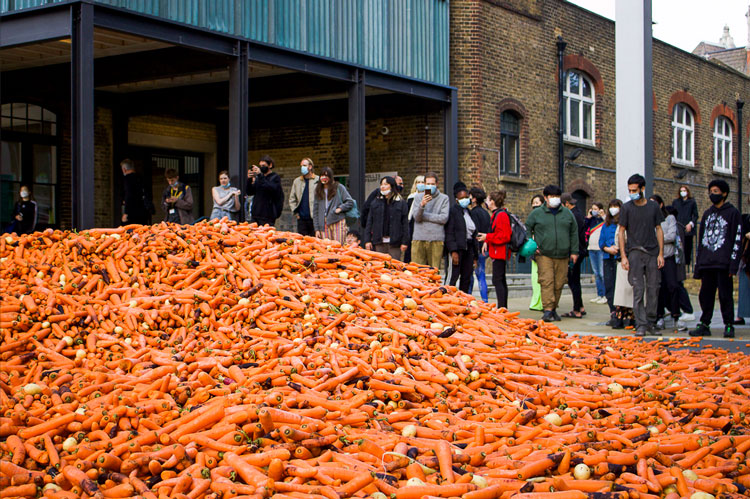
Rafael Pérez Evans. Grounding, 2020. 29 tonnes of carrots, truck, university glass building. Goldsmiths MFA. © Rafael Pérez Evans.
AMc: You were disembodied because the course was so conceptual?
RPE: Exactly. It’s a very heavy school, which I love, and which is why I went back to it, but, at the same time, that love is complex. Love is always a complex relationship.
I’ve been researching ecology studies for quite a number of years, again, partly because I felt it was so very metropolitan, urban, disconnected and dissociated, which mirrors my thinking around, and understanding of, food production. Grounding was a divisive piece. The response to it was very polarised. For me, it’s been really important to work with food. At an immediate level, food contains a lot of emotion. I have taken on board the responses around me contributing to global food waste. It’s made me think a lot. The piece was, however, only really a parking spot for the carrots, which went on to be used as animal feed. It was quite a punch for me to receive that level of response, and I’m still dealing with it, and simultaneously developing a project in Spain, with the curator Javier Orcaray, where we are also thinking about whether there could be a complete cycle, from the birth of the food to the return of the food, bringing about a much deeper engagement with the whole production and material of the work. It’s a complex thing. And I think the complexity also has to do with what, in my opinion, is the state of separation of the city from aspects of global food production, which I, on the other hand, fortunately – or by chance – grew up with. It’s familiar territory. I talk a lot about hyper-separation: the city has, in general terms, been separated from, and blinded to, what it takes for this one carrot to reach the shelf in the supermarket.
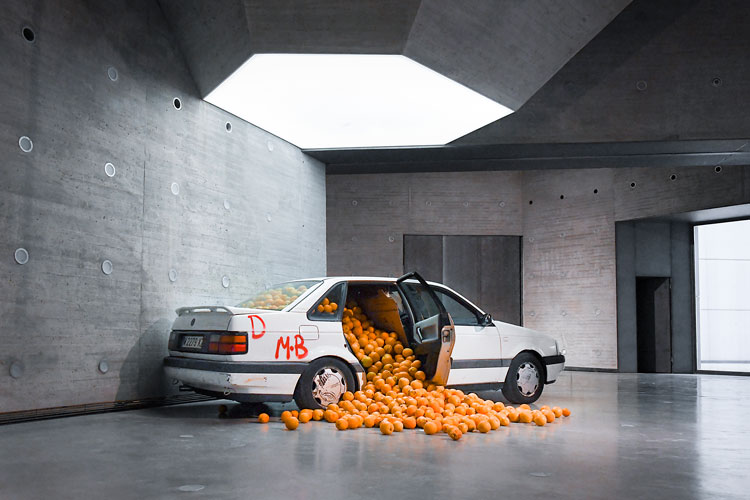
Rafael Pérez Evans. Thief, 2019. Car, cardboard, oranges. 6 x 3.5 x 1.70 m. C3A Museum. Spain. © Rafael Pérez Evans.
AMc: As you just said, you grew up in a farming community in Spain. I read that you said you moved to the city because you felt that freedom would be “outside” [the farming community]. Do you still feel that, or do you think you have lost something by moving?
RPE: I’m half-Spanish and half-Welsh, and, since I was a child, I have never fitted in. I think a lot of artists have that sense that we’re misfits and don’t fit into either one place or the other. As a queer person, as well, I grew up in a rural environment in which I felt that kind of freedom and salvation was only available in the city. That’s the narrative that the city tells, historically, also to workers, if you think about different points in history where there have been massive migrations of rural populations. They are always a political event. The city, in my opinion, even though I’m part of it, is a monstrous entity that sucks people in, like a vacuum. It takes in people, resources and energy, and rarely gives back. There’s a lot of current thinking around the metabolism of the city and its part in the global, ecological crisis we find ourselves in. And it was this metabolism that sucked me in, in a way.
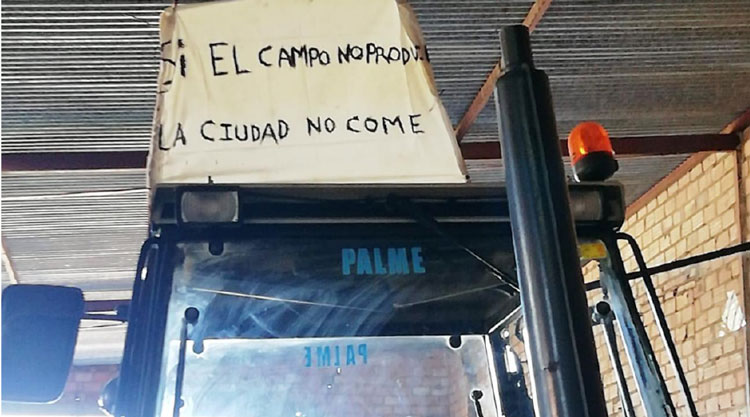
Rafael Pérez Evans. Archive image taken from Lanza Newspaper (Anonymous 2020) Farmers Placards, Spain. (If the countryside doesn't produce, the city doesn't eat).
Narratives of freedom are also tied in with prospects of work. When I was a kid, my dad, a Spaniard, always said: “You can work with me, or you can study.” Following the end of the dictatorship in Spain, in 1975, there was a rapid modernisation of the country, which, for a lot of people, meant this accelerated narrative that we needed to be more European, we needed to be more northern. I look a lot to the south: Pigs – Portugal, Italy, Greece, Spain. It’s a good term to start looking at the north-south division. A lot was forced on us. There was a lot of labour migration to the north, to the cities, and that brought about rapid cultural change for a lot of the communities comprising agricultural workers. They had to throw away their ways of living and working in order to adapt quickly to a new culture.
The reason I’m giving you this background is because it informs my work. A lot of these forces, pushing for communities to change, have to do with the cheapening of their products. And when you make something cheaper – milk, grain, vegetables – you are devaluing the price of the labour as well. My hometown, which, back in the day, was an agricultural and fishermen’s town in the south of Spain, in Málaga, very quickly transformed, from that kind of community and workforce, into part of the tourist sector. Those jobs were no longer suitable or financially viable for the communities. When the land, all of a sudden, is not sustainable for producing food, it becomes available for foreign investment. I call this “planting property”, which is what happened in southern Spain. It’s a new form of “planting”– a system that is stealing land, in a way.
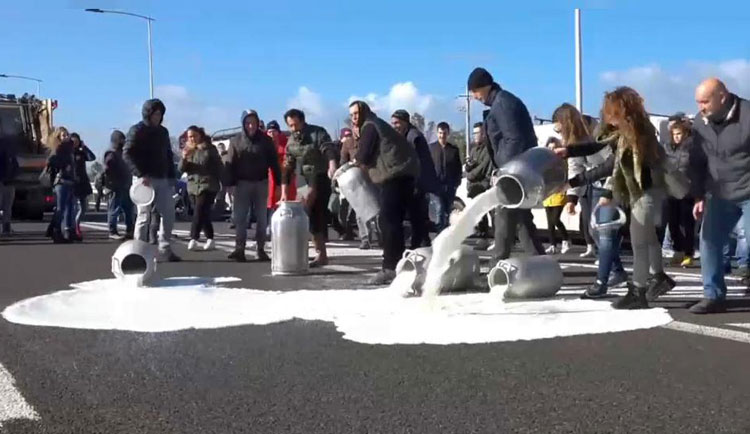
Rafael Pérez Evans. Reference image from press. 2019: Italian farmers dumping milk in protest over falling prices.
What I find interesting is how people react. How and when do we say no to this cheapening of labour, produce, food and, ultimately, the erasure of cultures? When do we protest? It’s very powerful to look at these changes from the perspective of materiality and sculpture, but, of course, they’re also embedded in a narrative of historical violence, power regimes and language. It’s emotive, charged territory. Going back to the Goldsmiths piece: it’s a scream. It’s a powerful form of language, which comes from the place that I’ve just been telling you about, a place of helplessness.
AMc: Would you say that the idea of protest is present in all your work?
RPE: Protest in the wider sense. For example, one of the pieces, Lake (2021), which I’m going to have at the Henry Moore Institute, involves flooding one of the galleries with milk. This is a gesture carried out by many European farmers in various cities – they create temporary “lakes” in the roads. They don’t call them lakes, but they throw their milk churns, and the white substance takes over certain spaces. It’s a punch because milk is so charged for all of us. We are born to milk, even though it’s not cow’s milk.
.jpg)
Rafael Pérez Evans. Lake Road. C-type print, 30 x 40 cm. © Rafael Pérez Evans.
Then, in a wider sense, I’ve also been looking at other territories such as queer pain and the violence in queer communities in various parts of the world. I was very fortunate to be able to work in the global south for a number of years. I developed works there that have a notion of protest, but protest in the much wider sense. There are certain narratives I feel need to be returned to, but none of these works is in this show. As a queer practitioner, who comes from a place of rurality as well as queerness, I talk a lot about the idea of shame. Of course, queerness is very attached to ideas and experiences of shame, but there is also something I call “rural shame”, which is a class thing, the notion of the countryside, at least in Spain, as being backwards. I have experienced this shaming from the lens of the heightened modernisation. To use certain language or to use certain behaviours is considered barbaric. Queerness and rurality meet at this point of the barbaric, of not fitting into a more bourgeois, normative form of behaviour and existence. I’m working towards building a bridge between those two worlds because I think that’s a good meeting point, at least for me in my own research, between these two experiences. It’s something more personal than just going through the lens of ecology. There are a lot of great people injecting the queer into ecological studies, too, but, for me, it’s about how rurality and queerness align in the vulnerability of being shamed.
AMc: Coming back to what you said before about Handful being the antithesis of very large-scale amounts of foodstuffs, such as butter mountains and grain mountains – outside the Henry Moore Institute you are installing a work entitled Mountain (2021), comprising two huge, galvanised metal grain silos. Is this primarily intended to draw the attention of passersby?
RPE: Again, I’m going with this monumental encounter, this element of surprise. I was very fortunate, with Grounding, in the sense that the audience had a bodily encounter, there was no escape. You could smell the carrots three roads away. People, who knew nothing about the show would smell the carrots and come to see what it was all about – and those people are really important. What’s also important is the way in which can you disrupt the urban flow, cause an encounter that throws someone a bit off balance, disorients them. It’s like early surrealist thinking – “This should not be here.”
In the 1960s, people such as Alejandro Jodorowsky, the Chilean-French author, film-maker, poet and magician, did a lot of these “city actions” and disrupting things. That experience is really important because there is something about being thrown off balance which is the moment when the work is doing something – being a handful in its other sense, being a nuisance. Similarly with the spilt milk. I’m quite clumsy as a person. I drop things all the time at home and in the studio. I can spend a long time working with things like that. Spilt milk is a nuisance, but I leave it there, let it rest, think: “This should not be here – it’s a pain,” but that pain takes me somewhere. Those encounters, material encounters in the city or in my home, are really important.
Mountain, here, refers to grain mountains, which is a term that got used after lots of stockpiling had been taking place in the EU and other parts of the world, centring on the idea of food security. We’re talking about immense amounts, tonnes and tonnes of produce, that are kept, which then affects the value of the produce from smallholdings. This has a direct effect on the farmers, so, again, the body becomes important in the encounter. The Henry Moore Institute has a large, black granite facade, and the silos are going to be standing against it. We are confronted with our own smallness and insignificance, similar to when experiencing a landscape. When we’re in the supermarket, we are the big ones, we are in control. It’s very satisfying, very pleasurable, almost like a hedonistic experience. You go in and take a little bit of this, a little bit of that, a little bit of whatever you like. But that’s not the scale I know. Growing up, we had boxes and boxes of lemons. My dad was also working in a cooperative, which has disappeared now, because of produce devaluation there are not enough smallholdings. Farmers in my hometown are disappearing, they’re being erased by real estate. So, what I’m trying to say here is that encountering that scale is really important. You feel small again.
The Spanish author Jaime Izquierdo talks about post-industrial society, and, over the past few years, has been developing the term “agropolitan” – the agropolitan city and the cosmopolitan village. What could a future city look like if food production were to become part of the urban landscape, if there were no separation, if the city became an agricultural space? He talks a lot about the edges of the city and reintegrating those spaces back into its circulation, language and narratives.
AMc: Have you seen much more change to this urban landscape over the past year, during the pandemic? Aside from agriculture, there has been a lot of talk about “urban nature” and bringing rural spaces back into the city for people’s wellbeing. Do you think people are responding differently to your work as a result?
RPE: I think those conversations are really great, but often depart from the issue of who is voicing what, and a lot of what I struggle with within the new ecology is that often it’s written for the city by the city. I’ve seen some really incredible projects in London, but, ultimately, who is touching the soil? A lot of the time in the UK – and in Spain, too – people don’t want to bend over and get their hands dirty. I think a lot about bending over – it’s a piece I’m making for the future, bodies bending down. We don’t want to – we want to be standing straight – erect, walking, not bending – so we bring in migrant workers. Again, that’s partly what I’m saying about Goldsmiths: it sounds good on paper, but who is touching the soil and getting dirty? I would like to build some new alliances to farming bodies, and I’m trying to do that in Spain at the moment with a group of people who are developing new networks of knowledge exchange. I would, however, just be a little cautious about the deification of the great countryside, because the countryside is also a place, historically, associated with pain and violence – at least in the southern Europe I know. It’s a place where bodies are and were exploited. The countryside is a noisy, complex place and ecosystem.
AMc: Can you say a little more about the idea of knowledge exchange and your wider interest in informal pedagogies?
RPE: This relates back to my being queer. My mother died, and so I went back to Spain to mourn and spend time with my family. My boyfriend at the time went with me, and we started rebuilding the farm space. Then my neighbour saw my boyfriend and me kissing, and it caused a local scandal. I always try to fight, but there’s a limit. I just didn’t feel free to build something there any more.
I really like the idea of art residencies, and my friend Marianne Soisalo had just moved from London to Brazil. She’s half-Finnish, half-Brazilian, and she started a project in a nature reserve in Alto Paraíso de Goiás. She invited me, and so my boyfriend and I moved there and started an art residency, Alto Residency, in this remote jungle area. We’re talking 2014, something like that. Alto Paraíso had been a mecca for new age thinkers and communities since the 60s, and I’m very interested in magic and new ageism. In this town there are more healers than people. It’s very quirky in that sense, and they had had a permaculture, biodynamic agriculture, for a long time. My friend was growing her own shiitake mushrooms in the jungle, as well as working with plant and animal protection, and there were lots of research scientists coming to study the monkeys, because there are very particular monkeys that live there. It was a very special place.
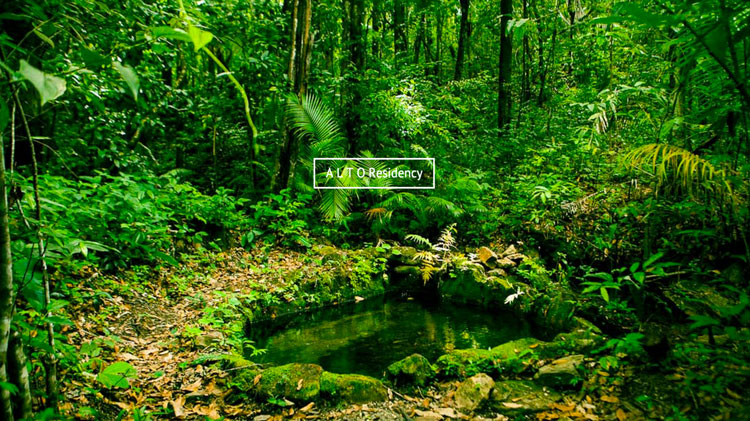
Rafael Pérez Evans. Alto Residency, 2014. Water Source. Alto Paraiso Goias. © Rafael Pérez Evans.
This is why I complain about separation and disconnection in western living. Life and thought. I was trying to develop the idea that life involves food. It involves sleep. It involves the body and the things we have to do throughout the day to maintain it. I don’t think these experiences – eating, sleeping, resting, thinking, researching, making – can be separated as they are in western academia. There is a such a complete separation. You don’t eat and talk. You don’t go to a lecture at Goldsmiths and have food at the same time. Why not? This was a really great opportunity for me to be with incredible people who came and stayed with us, and to develop a practice that was very much about not separating the living experience from the making and the thinking. It involved people from the Huni Kuin of the First Nation people of Brazil to zoologists, environmentalists, radical queer thinkers – all sorts of people. It was really a powerful place.
Another incredible residency is the Capacete Project in Rio [de Janeiro], where you go to lectures, and it’s like a party – cooking and eating, digesting information as you are digesting food. Something happens when you bring those two experiences together. Residencies like these offer an opportunity for people to try these things out, and it’s an ongoing thirst I have.
AMc: Is this something you try to carry through into your own daily practice and routine?
RPE: What happens in London, at least in my London, is that I can forget quite quickly. I have great friends, who are very much in that dimension, and they spin me back in. But there is always this battlefield about what it means to be an artist here, and what is expected. We’re all like parrots, just repeating what we see and hear around us. I have to surround myself with that other type of knowledge to keep it in my memory, to keep it in my circulation.
AMc: Do you have a specific daily routine?
RPE: I was very lucky to get a studio last year as part of a grant, but I’ve been shielding, and so the home has become my workspace. Art, for me, is a bit like a chemical experiment. You put one thing, you put another, and boom, something happens. I put things together, but there’s also a thing in between, which escapes. Most of the time, at home, I work conceptionally, but sometimes I work with materials, and I let the materials inhabit the domestic space. When I work with vegetables, like potatoes for example, I bring them into my house, and I live with them. A bunch of potatoes. Or, as I mentioned, I had a puddle of spilt milk. It was useless, it was annoying, but I lived with it for a day to see what happened when I encountered that material. My home and immediate surrounding area has become a bit like a lab. It’s really important for me to go to markets, because it brings me back to earth – the debris, the boxes and leftover vegetables, the smells – it brings me back to what I knew in my childhood. And I encounter a lot of things in these spaces which provoke my work. It can be something material, like a leftover, squashed tomato, and I might just take a photo. Those material encounters and smells provoke me to think and to engage until something happens, which is making work.
I think it’s important, at least for me, to be wary of the home becoming an office or workspace, however. I find it dangerous that there is no escape at all because we’re all trapped in phone land, pixel culture. I try to break the rhythm of the home. I move objects around, move the sofa, just so there’s something that keeps me awake.
AMc: Aside from farming and protest, where do you draw your inspiration? For example, which art historical movements or legacies or artists do you look to?
RPE: Robert Smithson has been a highly influential figure in my practice. For example, the work he did with Nancy Holt, including the video piece, Swamp (1971). It’s a simple work, almost nonsensical. In western culture, we have this idea of owning things and being able to go wherever we want, having control and mapping. In Swamp, you can’t get in. Similarly, the jungle is a place where you can’t get in. You can’t control it. Bodily, often there’s no way in. Such encounters are difficult and stop you from having it all – like sitting on a piece of chewing gum on the bus. I love that because it’s a nuisance. It’s something you can’t control. It’s going to take a while to peel it off.
Jimmie Durham, too. He has a level of humour that is arresting. Arresting is police language – however, if something arrests me, disarms me, I drop my weapons, security and protection. David Hammons – same thing. His work disarms me, his way of thinking disarms me. I’m hoping, with practice, I can arrive at that tonality of work. Things we encounter that momentarily disarm our bodies or our minds. There is something about being disarmed that allows for more things to come in. I’m interested in opening up those spaces through my practice.
AMc: Where do you see yourself in five or 10 years’ time?
RPE: Making work on a full-time level would be amazing. I love teaching as well, but having more time to work, just to make art, would be amazing. I would like to be able to start working with iconic architecture, such as the Mies van der Rohe Pavilion in Barcelona, for example. To start working against that kind of transparency, that glass in certain buildings. Or against a Dan Graham pavilion. I would like to start engaging my work with this iconic architecture, and artworks by other people, and to see what happens in that chemical experiment. Also just continuing with what I mentioned before, concerning pedagogies that are outside of western thought, continuing to develop and see where that takes me. That would be my dream.
• Rafael Pérez Evans: Handful is at the Henry Moore Institute, Leeds, from 18 May to 29 August 2021